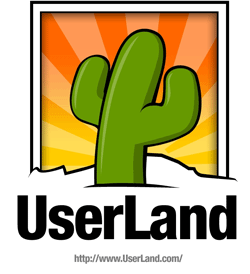
Dave Winer is an American software developer, entrepreneur, and writer who resides in New York City. Winer is noted for his contributions to outliners, scripting, content management, and web services, as well as blogging and podcasting. He is the founder of the software companies Living Videotext, Userland Software and Small Picture Inc., a former contributing editor for the Web magazine HotWired, the author of the Scripting News weblog, a former research fellow at Harvard Law School, and current visiting scholar at New York University's Arthur L. Carter Journalism Institute.
Gecko is a browser engine developed by Mozilla. It is used in the Firefox browser, the Thunderbird email client, and many other projects.
The Resource Description Framework (RDF) is a World Wide Web Consortium (W3C) standard originally designed as a data model for metadata. It has come to be used as a general method for description and exchange of graph data. RDF provides a variety of syntax notations and data serialization formats, with Turtle currently being the most widely used notation.

UserLand Software is a US-based software company, founded in 1988, that sells web content management, as well as blogging software packages and services.

RSS is a web feed that allows users and applications to access updates to websites in a standardized, computer-readable format. Subscribing to RSS feeds can allow a user to keep track of many different websites in a single news aggregator, which constantly monitor sites for new content, removing the need for the user to manually check them. News aggregators can be built into a browser, installed on a desktop computer, or installed on a mobile device.
Web syndication is making content available from one website to other sites. Most commonly, websites are made available to provide either summaries or full renditions of a website's recently added content. The term may also describe other kinds of content licensing for reuse.

The name Atom applies to a pair of related Web standards. The Atom Syndication Format is an XML language used for web feeds, while the Atom Publishing Protocol is a simple HTTP-based protocol for creating and updating web resources.
OPML is an XML format for outlines. Originally developed by UserLand Software as a native file format for the outliner application in its Radio UserLand product, it has since been adopted for other uses, the most common being to exchange lists of web feeds between web feed aggregators.

Netscape Browser is the eighth major release of the Netscape series of web browsers, now all discontinued. It was published by AOL, but developed by Mercurial Communications, and originally released for Windows on May 19, 2005.
Channel Definition Format (CDF) was an XML file format formerly used in conjunction with Microsoft's Active Channel, Active Desktop and Smart Offline Favorites technologies. The format was designed to "offer frequently updated collections of information, or channels, from any web server for automatic delivery to compatible receiver programs." Active Channel allowed users to subscribe to channels and have scheduled updates delivered to their desktop. Smart Offline Favorites, like channels, enabled users to view webpages from the cache.
OpenSearch is a collection of technologies that allow the publishing of search results in a format suitable for syndication and aggregation. Introduced in 2005, it is a way for websites and search engines to publish search results in a standard and accessible format.
Microformats (μF) are a set of defined HTML classes created to serve as consistent and descriptive metadata about an element, designating it as representing a certain type of data. They allow software to process the information reliably by having set classes refer to a specific type of data rather than being arbitrary.

In computing, a news aggregator, also termed a feed aggregator, content aggregator, feed reader, news reader, or simply an aggregator, is client software or a web application that aggregates digital content such as online newspapers, blogs, podcasts, and video blogs (vlogs) in one location for easy viewing. The updates distributed may include journal tables of contents, podcasts, videos, and news items.
FeedSync for Atom and RSS, previously Simple Sharing Extensions, are extensions to RSS and Atom feed formats designed to enable the bi-directional synchronization of information by using a variety of data sources. Initially developed by Ray Ozzie, Chief Software Architect at Microsoft, it is now maintained by Jack Ozzie, George Moromisato, Matt Augustine, Paresh Suthar and Steven Lees. Dave Winer, the designer of the UserLand Software RSS specification variants, has given input for the specifications.
GeoRSS is a specification for encoding location as part of a Web feed. (Web feeds are used to describe feeds of content, such as news articles, Audio blogs, video blogs and text blog entries. These web feeds are rendered by programs such as aggregators and web browsers.) The name "GeoRSS" is derived from RSS, the most known Web feed and syndication format.
Web syndication technologies were preceded by metadata standards such as the Meta Content Framework (MCF) and the Resource Description Framework (RDF), as well as by 'push' specifications such as Channel Definition Format (CDF). Early web syndication standards included Information and Content Exchange (ICE) and RSS. More recent specifications include Atom and GData.
Data feed is a mechanism for users to receive updated data from data sources. It is commonly used by real-time applications in point-to-point settings as well as on the World Wide Web. The latter is also called web feed. News feed is a popular form of web feed. RSS feed makes dissemination of blogs easy. Product feeds play increasingly important role in e-commerce and internet marketing, as well as news distribution, financial markets, and cybersecurity. Data feeds usually require structured data that include different labelled fields, such as "title" or "product".
The Publishing Requirements for Industry Standard Metadata (PRISM) for the Internet, computing, and computer science, is a specification that defines a set of XML metadata vocabularies for syndicating, aggregating, post-processing and multi-purposing content.





